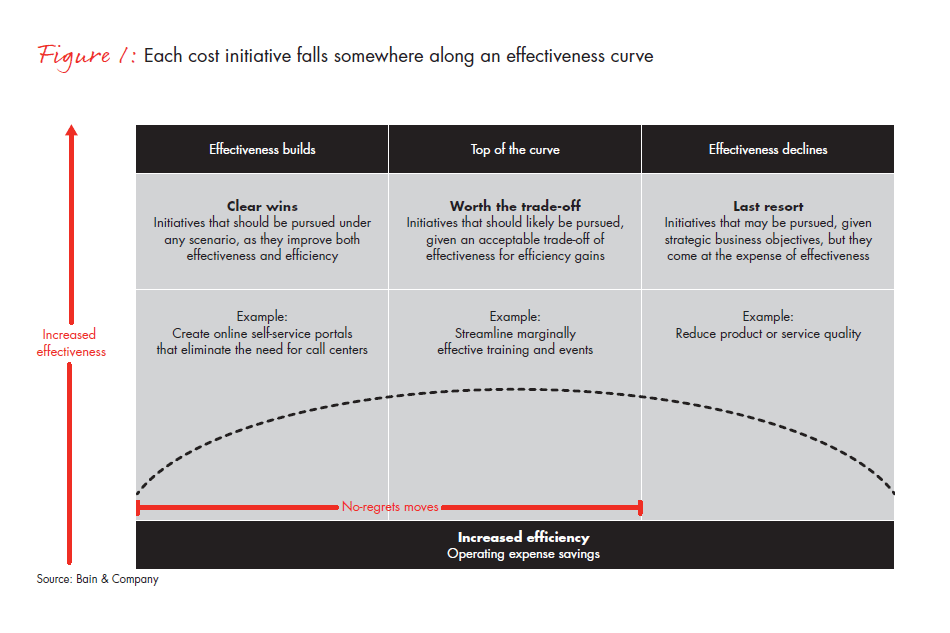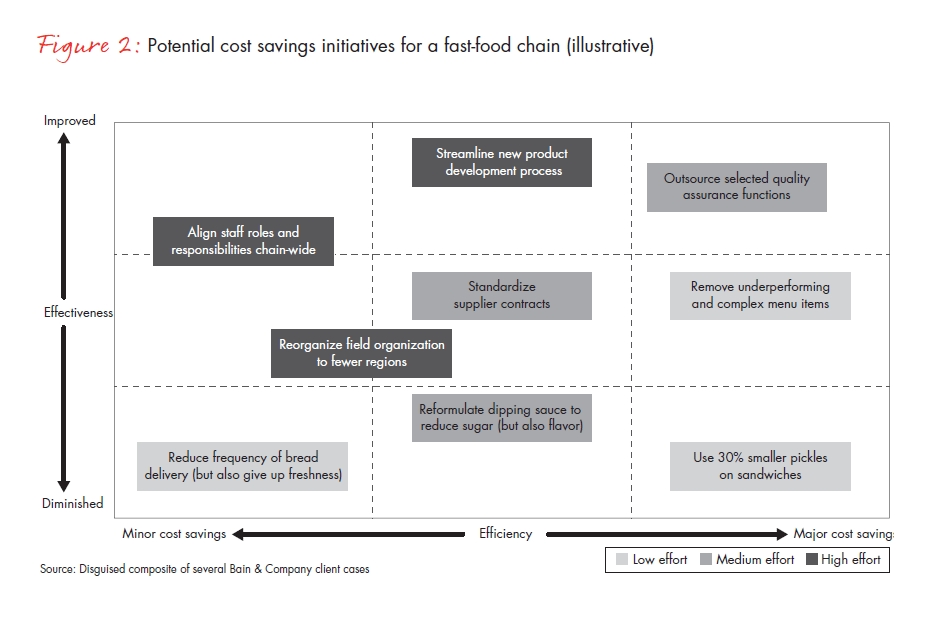Brief
Möglicherweise, wenn man sich vor Augen führt, wie Mitarbeiter daran arbeiten, betriebliche Abläufe nicht nur effizienter, sondern auch effektiver zu gestalten. Überflüssiges zu vermeiden, kann sehr befreiend wirken. Stellen Sie sich vor: Sie schauen auf die Kostensenkungen der letzten fünf Jahre zurück und haben dabei keinerlei Reuegefühle oder schlechte Erinnerungen.
Unternehmen, deren Geschäft während der Rezession rückläufig war oder die es sogar geschafft haben, die Lage stabil zu halten, haben aus den vorhandenen Ressourcen eine höhere Produktivität herausholen können. Allerdings werden solche Anstrengungen, insbesondere Kürzungen auf breiter Front, oft als vorübergehend und schädlich für das Geschäft erachtet, sobald nachhaltiges Wachstum zurückkehrt.
Aber Kostensenkungsmaßnahmen müssen keine Untergangsstimmung auslösen. In Vorzeigeunternehmen führen Kostenprogramme zu deutlichen Verbesserungen in der operativen Effektivität mit positiven Auswirkungen auf Finanzen, Kundenbeziehungen, Mitarbeiter und andere Bereiche. Der Schüssel zum Erfolg liegt darin, regelmäßig Kosteninitiativen „ohne Reue” zu verfolgen, die das Unternehmen schlanker und effektiver machen werden.
Es mag offensichtlich sein, dass man Kosteninitiativen verfolgen soll, die ein Unternehmen stärker machen oder zumindest angerichteten Schaden begrenzen. Aber in der Praxis sind die Motive für Kostensenkungen oft andere. Unternehmen neigen häufig dazu, Kürzungen als Reaktion auf einen konjunkturellen Abschwung oder Marktveränderungen vorzunehmen – oder weil sie unter dem Druck der Investoren stehen, innerhalb weniger Monate Ergebnisse liefern zu müssen. In einer solchen Situation ist es zu spät für konstruktivere Maßnahmen, die mehr Zeit bräuchten, um identifiziert, geplant und umgesetzt zu werden.
Cost-cutting initiatives can lead to a leaner, more effective company, or they can cause harm to an organization by tightening resources in the wrong places. Bain Partner Molly Kerr suggests that companies focus on three things that will help surface regret-free cuts.

They take an enterprise view in order to make valid comparisons of initiatives
Making fair comparisons of one business unit’s initiative with another department’s initiative requires using consistent metrics.
Start by plotting potential initiatives on a three-by-three grid, with one axis showing impact on effectiveness and the other showing efficiency gains (see Figure 2). Senior leaders should then discuss and challenge the relative placement of those initiatives, analyzing how each initiative would improve or hinder effectiveness, as well as testing the confidence level of estimated cost benefits.

This process can yield surprising results. At a fast-food chain, a management team debated a set of potential cost-reduction initiatives. One of the leading contenders, proposed by the supply chain group, was reducing the frequency of bread delivery, but that would have also reduced product freshness and degraded the customer experience. Only after the team took an enterprise-wide view did it uncover other initiatives that could yield big savings and actually improve effectiveness, such as outsourcing some quality assurance functions. This insight would have remained buried without an enterprise-wide view.
The corporate center has an important role in defining the metrics and the language of the cost-reduction effort, as well as ensuring that everyone plays by the same rules.
Typically, a cross-unit and cross-functional committee compiles and assesses all of the potential initiatives, arrays them on the effectiveness curve and winnows them down to a recommended handful of high-priority initiatives. With those recommendations, the ultimate go/no-go decision lies with a C-level executive, often the CEO.
Cost-consciousness need not imply risk aversion, but rather a search for value in all spending. Senior leaders no longer demand a 10% cost reduction; instead, they challenge employees to lower costs in ways that “make us a better company.” This gives managers permission to be creative about possible initiatives, research the economics of each one and present a range of options. With enough time and consistently applied effort to find the no-regrets initiatives, employees will rally behind the cause and companies will be able to fuel strong growth—without putting the business at risk.
A five-step program generates the no-regrets cost opportunities
- Assemble the right teams at the department, business unit or functional level. Often it’s midlevel managers who know where the organization could be more effective and the cross-functional teams who create breakthrough ideas.
- Get all ideas on the table. For any given unit at a large company, it’s worth generating between 200 and 1,000 idea fragments to consider. Using brainstorming software can ensure anonymity.
- Cluster and evaluate the ideas. Winnow and cluster the large group of fragments into 20 to 40 ideas—a more manageable number for evaluation with the appropriate analytical rigor.
- Rank and order the ideas using the effectiveness curve. Ranking potential initiatives takes several half-day working sessions to accomplish, with incremental research and analysis being conducted between sessions.
- Decide which initiatives to launch. It always makes sense to implement the “clear wins” and many of the “worth the trade-off” initiatives. A distressed business or one that needs to hit earnings targets may need to dip into the “last resort” category. If so, pick the initiatives that have the largest savings potential for the least damage to effectiveness. Teams may also identify the ideas that cost—rather than save—money to improve effectiveness, but set those aside for a period when the firm can afford the investment.
Molly Kerr is a Boston-based partner with Bain & Company’s Performance Improvement practice. Véronique Pauwels is an Amsterdam-based partner who co-leads the Performance Improvement practice in Europe, the Middle East and Africa.
